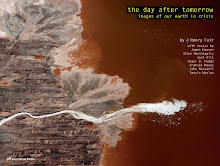Though I have photographed the Houston harbor petrochemical complex several times, there is much else to see along the coast which has eluded me. Southwings pilot, Tom Hutchings, evinced a similar interest and volunteered to make the trek down south along the coast to Mexico.
I booked a ticket to fly to Houston and meet him, but then the weather man spoke badly about the coming days. This is always the tough gamble: bet on the prediction and change all of the schedules, or go when it's the most convenient. This time I chose the former, changed my ticket, and as always the front rolled through a day after the man predicted. Generally a storm front is followed by clear weather, which is ideal for shooting, though often also a bumpy ride–not to be attempted by the weak of stomach. But it didn't work that way this time; the front was weak and came through late, so we did not have that bluebird day or two. When you throw dice with God, you take what you get and be glad you got out of the game at all, so off we went.

Our goals were grand, so we decided to do it in two days: Houston Harbor to Galveston and south to Freeport the first day, picking it up there the next day (after waiting out the weather) and going down to Corpus Christi, then even further south to the Mexican Border (had to indulge the pilot's whim on that). The Houston Harbor is fascinating (for those who are fascinated by the infrastructure that drives our world (40% of the refining capacity in the USA is along the Gulf of Mexico coast, and much of the petrochemical industry)). In the Harbor itself we photographed a few sites for environmental groups that were pursuing lawsuits, and otherwise pursued the current directions of the Industrial Scars project, which is recently tending to more mechanical abstracts than the fluid dynamics of the last show. Tom later told me, as this was the day before the front blew through, that the air was so thick that it was like a magic carpet ride to fly the plane, and of course I felt it as well.


Tom and I have flown together many times, and it's always a three-way contest of wills on these missions: him versus me, with the air traffic controllers trumping both. After looking at the BP refinery in Texas City, the site of so many disasters, we moved to Galveston, where I spotted several cruise ships docked in the bay. These things are tremendous environmental pigs, not to mention sociological fascinations, so I requested a flyover. Tom averred that there was nothing interesting there, and we were moving on, an outcome I was not about to accept. We started our collaboration on the BP Deepwater disaster, and our relationship is similar to that of combat veterans. I spotted a drill rig across the bay in the Haliburton dry docks and said, "Oh look, isn't that the Q4000 over there in drydock?" (the rig that did all the heavy lifting at the BP Deepwater site), and of course he could not help but fly-over to have a look, which took us right over the cruise ships, and they were as interesting as I has suspected. The rig in drydock was The Uncle John, a deepwater pipe-laying machine.

Over the coastline, we were immediately struck by the tremendous amount of construction right to the water's edge, and a six foot sea wall "protecting" Galveston City proper. Having just come through Hurricane Sandy, where so much coastal construction was destroyed, the topic of building near the water looms large in the national dialog. As we face the specter of ocean rise, wise planning would dictate a significant setback from the water. And in this era of budget constraints, taxpayer financed flood insurance is nothing short of a boondoggle. The houses along this coast are an invitation to the next hurricane, and one amusement park in particular reminded me of nothing if not a ball teed up to be swatted away.

Further southwest, we ventured to Freeport, home of one of the most poisonous chemical/plastics plants in the country, making nice things that insulate your house and surround you every day. Ironically, some of the most toxic things are the least photogenic, so aside from a few shots for documentation, we have not much to show. One other interesting thing in Freeport confronted us: two giant tanks connected by a complex pattern of pipes to a large array of fans. We flew around and around trying to ascertain the nature of the beast until it hit me: a compressor station for liquefying natural gas. Oh, the works of man. Thus ended the first day.






